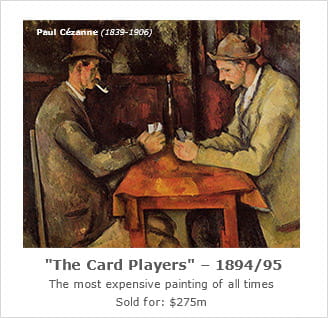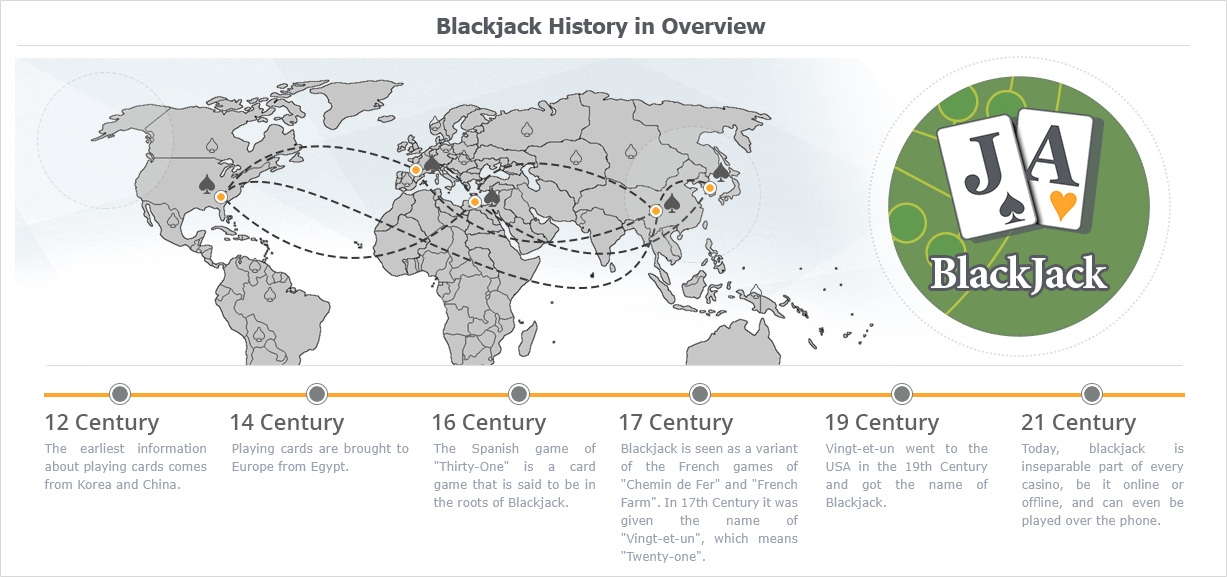History and Development of Blackjack
When thinking about card games, besides poker probably, the first game that comes to mind is blackjack. Thanks to its simple yet engaging rules and the way it is played, blackjack has been part of the gaming industry for centuries. Today there are many variants of the game, each with a unique set of rules and payoffs. Blackjack has been accepted widely by the online gaming community as well, since its uncomplicated play style is easily adopted in an online setting by veterans and new players alike. Let’s take a brief virtual tour through all the stages of the game development throughout the years, arriving finally at its current and very popular digital state.
Predecessors of Blackjack and How Card Games Developed
 There are several stories about the origin of card games and most differ wildly from one to the other. The oldest one has to do with the Chinese tradition of making cards out of copied paper money and using them for either gambling or playing for fun. Unlike European cards, the Chinese decks consisted of 30 cards. The preferred emblems painted on them were coins, strings of coins and myriads of strings of coins. The placement of the number was also different – the illustration was painted at the center with the numbers being displayed at the front up and bottom of the card.
There are several stories about the origin of card games and most differ wildly from one to the other. The oldest one has to do with the Chinese tradition of making cards out of copied paper money and using them for either gambling or playing for fun. Unlike European cards, the Chinese decks consisted of 30 cards. The preferred emblems painted on them were coins, strings of coins and myriads of strings of coins. The placement of the number was also different – the illustration was painted at the center with the numbers being displayed at the front up and bottom of the card.
The rest of the card origin theories come largely from the East, and focus on the early XIV century as a beginning for the card games development. These include the proto-Tarot cards used by Eastern European gypsies to predict the future; ancient Indian cards that have round edges and little or no connection to modern cards, and a Persian game called As Nas which is considered to be the ancestor of European cards. Various nations hold their own beliefs and accounts for different card games and often dispute a claim made by another state for a certain card game (Italy and France are amongst the fiercest competitors).
All theories aside, it has been proven that the earliest origins of card games in general can be traced to France, as early as 1392. These were largely influenced by Tarot cards brought from Egypt. In this period where knights, kings and lords were the predominant faces of society, modern cards got their famous suits we know today. The development process however involved many alterations, from cups, swords, coins and batons to the now standardized hearts, spades, diamonds and clubs. This card setup was established in the late 1400’s.
The Rise of Blackjack
Card games rose in popularity all over Europe – they were widely played in the aristocratic circles of Paris in France and all over the nation states in Italy. It is speculated that the game of blackjack might have its origin from these states though this is debatable. The strongest claim is made for the French game of Vingt-et-Un which has a meaning of “twenty-one” (pretty straight forward). It was played in French casinos in the 1700’s and is considered the earliest version of blackjack as we know it today.
Other countries have their own theories for the development of blackjack. For instance, in Spain, the game called “thirty-one” was actually a modified version of the standard game with a rule to get to 31 (instead of 21) with a minimum of three (as opposed to 2) cards. The Italians on the other hand claim that blackjack has its roots set in a much older period, when the Roman Empire was still around and they used to play game with wooden blocks with numeric values that is strangely reminiscent of blackjack. No matter the similarities, contemporary blackjack is considered to be a successor to Vingt-et-Un.
Infographics: History and Development of Blackjack
Evolution of Blackjack in the US
The game of 21, as it was known at the time, become very popular in the US after France got paralyzed by the French Revolution in 1789. There won’t be a name change until later on – the game would be known as 21 around the USA, a name firstly used in New Orleans in 1823. Clever casino owners in the US managed to entice a huge following of players thanks to their excellent bonus deals attributed to the game, namely the hand of Jack and Ace of Spades for a 10:1 payout. This would quickly become the staple of the game and with it came the eventual name change to Black-Jack.
While in Europe blackjack was being played mostly for entertainment, in the US casinos and players alike tried to take advantage of the rising popularity of the game by changing the odds and enforcing different bets to make the biggest profit they could. Since there was no governing body to prevent cheating and provide regulation, the casino market and blackjack were booming in popularity. This, however, was stopped at the beginning of the 19th century with the new gambling acts that prohibited games which could lead to corruption and organized crime.
Blackjack truly flourished in the US after the Nevada Gambling Act in 1931 which legalized casino gambling in the state. It was the main attraction for many new and existing players, in and outside of the US who were visiting Las Vegas casinos and having a blast with the game. Blackjack was recognized as one of the founding games for the modern generation of gambling and card games in general.
Mathematical Aspects: Strategies and Winning Chances
 With the ever-growing popularity of blackjack in casinos it was only a matter of time until people started tinkering with the idea of increasing one’s chances of winning at the game. As most players already know, the game isn’t about getting as close to 21, but about beating the hand the dealer has. It was with this logic that Roger Baldwin approached the problem using mathematics to create a strategy for improving the odds at blackjack. His paper, “The Optimum Strategy of Blackjack” was the first attempt to harness mathematical formulas and practices in order to lower the house edge and win more easily. The concept was expanded by Dr. Edward Thorp in the 60’s with the help of advanced computing algorithms that were used to create the first card counting systems. Since then, the casinos and players alike have been playing a game of cat and mouse, each trying to develop a strategy and set of rules to beat the other. Today, card counting is a forbidden practice in most casinos, however players can still use it to their advantage. Casinos have added new elements in blackjack such as higher deck count and higher shuffles in order to make the practice of card counting more difficult for players. If you would like to learn more about strategies, we can offer you a useful article on that.
With the ever-growing popularity of blackjack in casinos it was only a matter of time until people started tinkering with the idea of increasing one’s chances of winning at the game. As most players already know, the game isn’t about getting as close to 21, but about beating the hand the dealer has. It was with this logic that Roger Baldwin approached the problem using mathematics to create a strategy for improving the odds at blackjack. His paper, “The Optimum Strategy of Blackjack” was the first attempt to harness mathematical formulas and practices in order to lower the house edge and win more easily. The concept was expanded by Dr. Edward Thorp in the 60’s with the help of advanced computing algorithms that were used to create the first card counting systems. Since then, the casinos and players alike have been playing a game of cat and mouse, each trying to develop a strategy and set of rules to beat the other. Today, card counting is a forbidden practice in most casinos, however players can still use it to their advantage. Casinos have added new elements in blackjack such as higher deck count and higher shuffles in order to make the practice of card counting more difficult for players. If you would like to learn more about strategies, we can offer you a useful article on that.
Today You Can Play Blackjack Online
The online gaming industry boom happened in the early 90’s, with casino software emerging to encompass various games that were a staple of the industry. Blackjack has made the transition online easily, with its many variants being transferred in an online environment. Most online casinos offer the traditional version of Blackjack with 6 decks, though there are many other varieties available like Vegas Blackjack, Double and Single Deck Blackjack, Pontoon, Progressive Blackjack and some more. Online blackjack games sometimes come with a live option, i.e. being hosted by a professional dealer and streamed via live-feed. A popular option that has emerged is the Multiplayer Blackjack which offers incentives in the form of competitive play and multiplayer bonuses. You may read more about the various types of the blackjack game here.
The advantages offered by online blackjack games are numerous. While they’re not as inviting and exciting as games played in a brick-and-mortar casino, the graphics and authentic sounds create a unique environment that is accessible from your own home. The various options for fun play and instant switch to playing for money is also streamlined and offers greater choice and possibility to earn additional bonuses only available for online players.